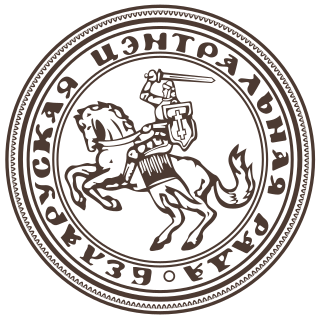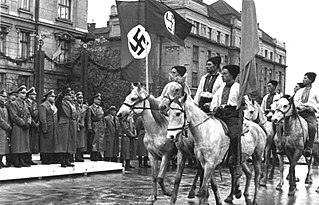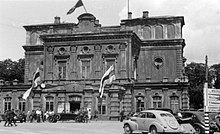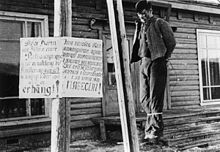
The Byelorussian Soviet Socialist Republic, also known as Byelorussia, Belorussia, Belarusian SSR, Soviet Belarus, or simply Belarus, was a republic of the Soviet Union (USSR). It existed between 1920 and 1991 as one of fifteen constituent republics of the USSR, with its legislation from 1990 to 1991. The republic was ruled by the Communist Party of Byelorussia and was also referred to as Soviet Byelorussia or Soviet Belarus by some historians. Other names for Byelorussia included White Russia or White Russian Soviet Socialist Republic and Belorussian Soviet Socialist Republic.

The Dirlewanger Brigade, also known as the SS-Sturmbrigade Dirlewanger (1944), or the 36th Waffen Grenadier Division of the SS, or The Black Hunters, was a unit of the Waffen-SS during World War II. The unit, named after its commander Oskar Dirlewanger, consisted of convicted criminals. Originally formed from convicted poachers in 1940 and first deployed for counter-insurgency duties against the Polish resistance movement, the brigade saw service in German-occupied Eastern Europe, with an especially active role in the anti-partisan operations in Belarus. The unit is regarded as the single most brutal and notorious Waffen-SS unit, with its soldiers described as the "ideal genocidal killers who neither gave nor expected quarter".

The Belarusian Central Council was a puppet administrative body in German-occupied Belarus during World War II. It was established by Nazi Germany within Reichskommissariat Ostland in 1943–44, following requests by collaborationist Belarusian politicians hoping to create a Belarusian state with German support.

The Slutsk affair refers to the massacre of thousands of Jews and others that occurred in Slutsk, Byelorussia in the Soviet Union, in October 1941, near the city of Minsk while under German occupation during World War II. The perpetrators were a combination of Gestapo special forces and Lithuanian allies of the Third Reich. Nearly 4,000 Jews were murdered over a two-day period along with thousands of non-Jews.

The military occupation of Latvia by Nazi Germany was completed on July 10, 1941, by Germany's armed forces. Initially, the territory of Latvia was under the military administration of Army Group North, but on 25 July 1941, Latvia was incorporated as Generalbezirk Lettland, subordinated to Reichskommissariat Ostland, an administrative subdivision of Nazi Germany. Anyone not racially acceptable or who opposed the German occupation, as well as those who had cooperated with the Soviet Union, was killed or sent to concentration camps in accordance with the Nazi Generalplan Ost.

The Belarusian resistance during World War II opposed Nazi Germany from 1941 until 1944. Belarus was one of the Soviet republics occupied during Operation Barbarossa. The term Belarusian partisans may refer to Soviet-formed irregular military groups fighting Germany, but has also been used to refer to the disparate independent groups who also fought as guerrillas at the time, including Jewish groups, Polish groups, and nationalist Belarusian forces opposed to Germany.

When the Second World War in Europe began, the territory which now forms the country of Belarus was divided between the Soviet Union and the Second Polish Republic. The borders of Soviet Belarus were greatly expanded in the Soviet invasion of Poland of 1939. In 1941, the country was occupied by Nazi Germany. Following the German military disasters at Stalingrad and Kursk, the collaborationist Belarusian Central Council (BCC) was formed by the Germans in order to raise local support for their anti-Soviet operations. The BCC in turn formed the twenty-thousand strong Belarusian Home Defence (BKA), active from 23 February 1944 to 28 April 1945. Assistance to collaborators was offered by the local Soviet administrative governments, and prewar public organizations including the former Soviet Belarusian Youth. The country was soon retaken by the Red Army in 1944. Devastated by the war, Belarus lost significant populations and economic resources. Many battles occurred in Belarusian territory. Belarusians also participated in the advance towards Berlin.
Khatyn was a village of 26 houses and 157 inhabitants in Belarus, in Lahoysk Raion, Minsk Region, 50 km away from Minsk. On 22 March 1943, almost the entire population of the village was massacred by the Schutzmannschaft Battalion 118 in retaliation for an attack on German troops by Soviet partisans.

Ukrainian collaboration with Nazi Germany took place during the occupation of Poland and the Ukrainian SSR, USSR, by Nazi Germany during the Second World War.
Belarusian resistance movement are the resistance movements on the territory of contemporary Belarus. Wars in the area - Great Northern War and the War of the Polish Succession - damaged its economy further. In addition, Russian armies raided the Polish–Lithuanian Commonwealth under the pretext of the returning of fugitive peasants. By mid-18th century their presence in the lands of modern Belarus became almost permanent.
The Belarusian Home Defence, or Belarusian Home Guard were collaborationist volunteer battalions formed by the Belarusian Central Council (1943–1944), a pro-Nazi Belarusian self-government within Reichskommissariat Ostland during World War II. The BKA operated from February 23, 1944 to April 28, 1945. The 20,000 strong Belarusian Home Defence Force was formed under the leadership of Commissioner-General Curt von Gottberg, with logistical help from the German 36th Waffen Grenadier Division of the SS known as the "Poachers' Brigade" commanded by Oskar Dirlewanger.
The Holocaust in Belarus refers to the systematic extermination of Jews living in the Byelorussian Soviet Socialist Republic during its occupation by Nazi Germany in World War II. It is estimated that roughly 800,000 Belarusian Jews were murdered during the Holocaust. However, other estimates place the number of Jews killed between 500,000 and 550,000.

The Belarusian Auxiliary Police was a German force established in July 1941 in occupied Belarus, staffed by local inhabitants, considered collaborationist. In western Belarus, auxiliary police were formed in the form of Schutzmannschaften units, while in the east they were formed in the form of Ordnungsdienst.

Schutzmannschaft-Brigade Siegling was a Belarusian Auxiliary Police brigade formed by Nazi Germany in July 1944 in East Prussia, from six auxiliary police battalions following the Soviet Operation Bagration.

During World War II, some Belarusians collaborated with the invading Axis powers. Until the beginning of Operation Barbarossa in 1941, the territory of Belarus was under control of the Soviet Union, as the Byelorussian Soviet Socialist Republic. However, memories of Soviet repressions in Belarus and collectivization, as well as of the polonization and discrimination against Belarusians under the Second Polish Republic were still fresh.

Schutzmannschaft Battalion 118 was a Schutzmannschaft auxiliary police battalion (Schuma). The core of the Schutzmannschaft battalion 118 consisted of Ukrainian nationalists from Bukovina in western Ukraine, and the unit included other nationalities. It was linked to the ultra-nationalist Organization of Ukrainian Nationalists (OUN), to its smaller Melnyk wing. Nine-hundred members of the OUN in Bukovina marched towards eastern Ukraine as members of the paramilitary Bukovinian Battalion. After reinforcement by volunteers from Galicia and other parts of Ukraine, the Bukovinian Battalion had a total number of 1,500–1,700 soldiers. When the Bukovinian Battalion was dissolved, many of its members and officers were reorganized as Schutzmannschaft battalions 115 and 118. Among the people incorporated into the Schutzmannschaft battalions 115 and 118 were Ukrainian participants in the Babi Yar massacre.

Bronna Góra is the name of a secluded area in present-day Belarus where mass killings of Polish Jews were carried out by Nazi Germany during World War II. The location was part of the eastern half of occupied Poland, which had been invaded by the Soviet Union in 1939 in agreement with Germany, and two years later captured by the Wehrmacht in Operation Barbarossa. It is estimated that from May 1942 until November of that year, during the most deadly phase of the Holocaust in Poland, some 50,000 Jews were murdered at Bronna Góra forest in death pits. The victims were transported there in Holocaust trains from Nazi ghettos, including from the Brześć Ghetto and the Pińsk Ghetto, and from the ghettos in the surrounding area, as well as from Reichskommissariat Ostland.

Hryhoriy Mykytovych Vasiura was a Soviet senior lieutenant in the Red Army who was captured during the Nazi invasion of the USSR in 1941 and subsequently volunteered for service in the Schutzmannschaft and the Waffen-SS. Vasiura's wartime activities were not fully revealed until the mid-1980s, when he was convicted as a war criminal by a Soviet military court and executed in 1987 for his role in the Khatyn massacre.

Generalbezirk Weißruthenien was one of the four administrative subdivisions of Reichskommissariat Ostland, the 1941–1945 civilian occupation regime established by Nazi Germany for the administration of the three Baltic countries and the western part of the Byelorussian SSR.
Wartime collaboration occurred in every country occupied by Nazi Germany during the Second World War, including the Baltic states. The three Baltic republics of Estonia, Latvia and Lithuania, first invaded and occupied by the Soviet Union in summer 1940, were later occupied by Germany in summer 1941 and incorporated, together with parts of the Byelorussian Soviet Socialist Republic of the U.S.S.R., into Reichskommissariat Ostland. Collaborators with Germany participated in the Eastern Front against the Soviet Union, as well as in the Holocaust, both in and outside of the Baltic States. This collaboration was done through formal Waffen-SS divisions and police battalions, as well as through spontaneous acts during the opening of the war.






















